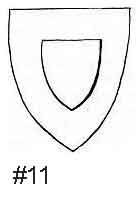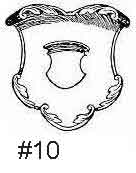

3. Jan of Bidziny
Jan of Bidziny (1,2,3,4,5,6,7,8,9,10,11,12,13,14,15,16,16a,16b), the owner of Kaszów, Gulin and Wysokie may be considered a progenitor of Guliński, Kaszowski and Bidziński branches of Janina clan.
Based on 1378-1425 documents, Jan of Bidziny of Janina clan (17) was born around 1357, and lived about 68 years. Most likely he was
born in Bidziny, near Opatów, in Sandomierz Province. His sons described themselves as from Bidziny, as well (11).

Jan lived during interesting period in Polish history, at the time of battles for Polish crown, beginning of Jagiellon dynasty, and famous Battle of Tannenberg. Actively he participated in the happenings of that period.
In 1378 Jan bought part of Wysokie, the property located South of Lublin. (6) Later, he moved to Kaszów, in Radom vicinity. He proofs his residency in 1409 in the document, where he states, "Me, Jan of Kaszów" (7). Possibly, the large size of this property caused Jan to move to Kaszów. Other documents indicate, that his far relative, Jan of Podlodów, also bought or received properties around Radom, where he moved in.
Jan can be assigned to wealthy Małopolan knights group. He owned properties in Bidziny, Wysokie, Kaszów, Wola Kaszowska and Gulin. Like other clan member, he backed Małopolan pro-Anjou party, and participated in fights against other solutions, including Mazovian Prince Ziemowit III. For his military merits, in 1398, Jan received a position of Sandomierz province standard-bearer. In 1421, as about 64 years old man, Jan received a position of Sandomierz castle stolnik. Historian Borkowski (18) presents Jan as stolnik of Cracow, but author check only one document. Many other documents show Jan, as stolnik of Sandomierz castle.
Jan, Sandomierz Standard-bearer, to the fields of Tannenberg brought twenty ninth provincial company. According to the sources, Sandomierz Palatine, Mikołaj of Michałów fought under his clan company. (19,20)
Jan was quite rich and religious person. He founded two churches. In 1409 he founded st. John Baptist church in Kaszów (7,14), and later in 1413 (5,8) church in Wysokie. Wysokie church founding document presents two co-founders: the bishop and Jan. Historian Stanisław Kuraś statement, that Jan only indirectly participated in founding process (8a) is not correct.

It is unknown, if properties in Kaszów and Gulin Jan heredited, received as a grant, or he bought these properties. In 1423 Jan divided his wealth among children. The same year, his sons Marcisz and Dersław gave Jan lifelong management rights to all properties (10,11). During Jan's assignment as Sandomierz stolnik, (6) in 1425, Jan placed city of Wysokie, south of Lublin. The city continued to use this status till eighteen century. This foundation document caused some concern of S. Kuraś, as the document did not include king's agreement.
Jan originated several financial documents, and was a witness in other documents. One of documents of national importance Jan witnessed, was in 1419 the one, originated by King Władysława Jagiełło and Witold, Prince of Lithuania, that confirms peace treaty with Danish King, Erick. (21)
We know very little about Jan's personal life. He was married twice, but there are no records describing his brothers, sisters, or his parents. The property, he comes from, is little known as well. In 1327, in village of Bidziny a parish church was located, possibly founded by Jan's grand father (22). The status of church patronge law, is unknown. For some reasons other clan members, Jan of Gierczyce and his brother Mikołaj of Kaliszany in 1407 donated small property to the church (23).
Sułek of Bidziny witnessed two documents from 1339 and 1347. Such brief, and the only information unfortunately cannot help to determine Sułek relationship to Jan of Bidziny.
4. Marcisz and Dersław

Jan had two sons Marcisz, and Dersław. Jan's daughter Katarzyna, in w 1398 married Dersław or Jan of Janowice, of Łabędź clan (2,24). Jan's daughter from the other wife was Anna. (2)
Marcisz, the older brother (2,4,10,11) according to medieval rules heredited Bidziny property. His children were sons Bernard, and Mikołaj (35), and unnamed daughters. Possibly, Wydzga of Bidziny, who in 1448 witnessed document (38), was also Marcisz son.
Dersław was born around 1390 in Bidziny. According to Długosz, in 1411 Dersław called himself Kaszowsky, "of Gulina", or Gulynsky. After father's property division, Dersław owned Kaszów, Wola Kaszowska, and Gulin. (2,3,4,10,11,25,26,27,28,29,30) Size of properties indicates a sample: Wola Kaszowska property of 20 łan kmieci (31) gave tithes to Sandomierz chapter valued at 16 to 20 grzywna (32,17,33). In 1435, for 100 grzywna Dersław bought property and city of Wysokie from his nephew, Mikołaj of Bidziny (25). In 1430 married Jadwiga, a daughter of Jan of Falków, of Doliwa home (4,26,29,30,34), whom in 1434 designated 200 marek of dowry on Kaszów and Wola Kaszowska properties. In 1441, Jan of Falków signed an agreement with Dersław about succession of Jan wealth, in case of his death without male descendants (26).
Dersław's neighbour was a co-claner, Jan Podlodowski of Przytyk. In 1451 Dersław has a court case with Jan Podlodowski family, on Wola Sułkowska property (28).
The person, whose relationship to Dersław is unknown, was Piotr of Gulin, and his son Mikołaj (4,34). In 1443 Mikołaj designated dowry to his wife Małgorzata, a daughter of Mikołaj of Chomętowo, Bończa clan (36,4,37).
In order to find the filiations of Jan of Bidziny descendants, very helpful would be Radom city and regional documents (akta ziemskie i grodzkie radomskie), the ones used by Boniecki, and others. Unfortunately all these document were completely destroyed during WWII.
To the fields of Tannenberg Jan brought the sixth provincial company. It is unknown, if Marcisz and Dersław participated in
the battle (39). In 1432 - 1435 Dersław kept the position of Lublin province standard-bearer (4). In 1436 at knights meeting
in Sieradz, he witnessed Brzeg peace treaty document. In 1450 King Kazimierz Jagiellończyk ordered businessmen of Krasnystaw
to travel to Sandomierz and Cracow provinces, using the road that crossed town of Wysokie. Surely, the fact of customs charges
imposed on merchants improved financial status of the city, and his owner.
Probably both brothers took a part in a war
against Teutonic Order, in 1454 - 1466. Per documents, Dersław was deceased in 1456 (34).
Geographic type of Jan's property division, and siginificant distance between Bidziny located on the southern slope of Świętokrzyskie Mountains, and Kaszow properties caused the early development of Bidziński branch, from the common tree. In next hundred fifty years, excluding Wysokie, Dersław's descendants lived in adjacent properties divided only by Radomka River.
K. Potkański, who wrote about Radom forest made interesting statement. According to him, two factors play the role in arrangement of the country population: the rivers and the mountains. Due to lower soil fertility, and communication difficulties, the mountains divide people. Rivers, in the contrast, create communication, and as result connect people together (40).

5. Descendants of Dersław: Jan, Mikołaj, and the daughters
Jan b.~1420 (3,4,17,27,47), son of Dersław, received Gulin and Wola Gulińska. Also, he owned Długojów property. Długosz described him as "Gulynsky" (41). According to the marriage contract signed in 1448 and 1453, Jan allocated to his wife Małgorzata 440 grzywna (43) of dowry and marriage portion. It is unknown what wealth Małgorzata brought to the marriage. In 1456 Jan sold Długojów (43), and Wola to Gutowski (42). Dersław, son of Jan, who owned Gulin in 1508 (44), most likely died heirless, because Gulin property was transferred to his cousin. Jan's daughter, Katarzyna, in 1526 married Mikołaj Rusinowski (44).
Mikołaj b.~1420 (4,34), second Dersław son, owned Kaszów, Wola Kaszowska and Wysokie. With his wife, Zbigniew (4,45) had three sons: Jan, who in 1475-1482 was Radom functionary (46,47,48), Łukasz, Chamberlain of Lublin in 1514, and the owner of Wysokie, and Stanisław, the owner of Gulin and Kaszów. Anna, daughter of Mikołaj, in 1546 married Zygmunt Pełka, Starost of Opoczno (49). Mikołaj's name exist in 1508 draft registers (50).
Jan and Mikołaj can be assigned to the midddle wealthy group of knights of Małopolska.
Most likely their father's conflict with Podlodowski family was not solved. Finally, in 1516, Zbigniewa, and her sons signed an agreement with Podlodowski family (45).
Jadwiga, Dersław's daughter before 1450 married Jan Mściwój of Skrzyńsko, of Łabędź clan (4,51,52,53,54,55,56), starost of Opoczno. Jan was a son of Mściwój, and the grandson of Otton. Her sister, Dobrochna, in 1465 married Jan of Janików, the son of Dobiesłw (4,51). It is unknown, if Jan of Falków, of Doliwa clan, son-in-law of Dersława, with whom signed an agreement about heredity, was a husband of Jadwiga, Dobrochna, or other unknown Dersław daughter.
XIV and XV century knight's armours presents the picture A and B.
Genealogical tree of Kaszowski-Guliński branch of Janina clan, is shown here.
continuation